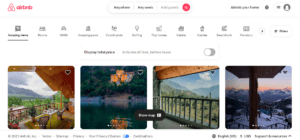In the fast-paced digital world, where attention spans are dwindling, the success of a website hinges upon its ability to captivate and engage visitors.
Good web design plays a pivotal role in creating immersive user experiences that leave a lasting impact. According to a study by Google, 53% of mobile users will abandon a website if it takes more than three seconds to load.
Keeping the average web user in mind at all times, this blog will dive deep into the complexities of good web design, examining what works and why.
Fundamentals of Good Web Design
1. Visual Appeal and User Experience
The first impression is crucial, and visual appeal plays a significant role in capturing the attention of visitors. A well-designed website reflects professionalism, credibility, and attention to detail, establishing trust and enticing users to explore further.
By employing aesthetically pleasing color schemes, balanced layouts, and intuitive navigation, businesses can create an inviting online presence that leaves a positive impression.
Example: Apple – A Masterclass in Minimalistic Design
One prime example of exceptional web design is Apple‘s official website. Embracing a minimalist approach, Apple uses ample white space, sleek typography, and striking product imagery to deliver a visually stunning experience.
By keeping the focus on their products and prioritizing simplicity, Apple creates an environment that allows users to seamlessly interact with their offerings.

2. Responsiveness and Mobile-Friendliness
With the exponential rise of mobile devices, ensuring a responsive and mobile-friendly design is paramount. Good web design adapts effortlessly to various screen sizes, enabling users to access content without any hindrances.
By employing responsive frameworks and optimizing layout and images, businesses can cater to the ever-growing mobile audience, boosting engagement and user satisfaction.
Example: Airbnb – An Exemplar of Mobile Optimization
Airbnb, the popular vacation rental platform, excels in mobile optimization. Their website provides a seamless user experience across devices, allowing travelers to effortlessly browse and book accommodations on the go.
By leveraging responsive design techniques, Airbnb ensures that their website remains user-friendly, regardless of the device being used.

3. Usability and Intuitive Navigation
In the realm of good web design, usability, and intuitive navigation are crucial elements that enhance user experience. Websites should be easy to navigate, allowing visitors to find desired information swiftly. Attention all Patek Philippe aficionados on a budget! Economical fake Patek Philippe watches are now within your reach!
Intuitive menus, clear calls to action (CTAs), and well-structured content contribute to a seamless user journey, reducing friction and increasing engagement.
Example: Amazon – Streamlined Navigation for Easy Access
Amazon, the e-commerce giant, showcases a commendable example of intuitive navigation. With their user-friendly interface and clearly labeled categories, users can effortlessly find the products they desire.
Amazon’s extensive search functionality and personalized recommendations further enhance usability, providing a tailored experience that keeps customers coming back.

4. Loading Speed and Performance Optimization
In an era of instant gratification, slow-loading websites can quickly discourage users. Good web design prioritizes performance optimization to ensure swift loading times.
By compressing images, minifying code, and leveraging caching techniques, businesses can deliver a snappy browsing experience that keeps visitors engaged and prevents them from seeking alternatives.
Example: Google – A Testament to Speed and Performance
Google, the world’s most popular search engine, sets an exceptional benchmark for loading speed and performance optimization. Their clean and minimalist design ensures quick loading times, allowing users to access search results in the blink of an eye.
Google’s relentless focus on speed reflects their commitment to delivering the best user experience possible.

5. Clear and Compelling Messaging
Compelling messaging is a cornerstone of good web design. By crafting concise, persuasive copy, businesses can effectively communicate their value proposition and engage visitors. Clear headings, engaging taglines, and concise descriptions can captivate users, compelling them to explore further and take desired actions.
Example: Slack – Engaging Copy for Effective Communication
Slack, the popular team collaboration platform, excels in clear and compelling messaging. Their website features concise, benefit-driven copy that highlights the platform’s value in a compelling manner.
By articulating the advantages of their product and resonating with their target audience, Slack successfully entices users to sign up and embrace their services.

6. Call-to-Action (CTA) Optimization
A well-optimized call-to-action (CTA) can significantly impact conversion rates. Good web design strategically places CTAs throughout the website, guiding users toward desired actions.
By employing contrasting colors, persuasive language, and placement in key areas, businesses can increase the likelihood of users taking the desired next steps.
Example: HubSpot – Effective CTAs for Lead Generation
HubSpot, a leading inbound marketing platform, exemplifies the art of effective CTAs. Their website strategically places CTAs at pivotal stages of the user journey, enticing visitors to download valuable resources, sign up for newsletters, or request demos.
HubSpot’s optimized CTAs play a vital role in lead generation, facilitating the growth of their customer base.

7. Embracing Accessibility
As inclusivity gains importance, web design must evolve to accommodate users with diverse needs. Good web design embraces accessibility principles, ensuring that websites are usable by individuals with disabilities.
By implementing proper color contrast, providing alt text for images, and incorporating keyboard navigation, businesses can create an inclusive online environment that welcomes all users.
8. Embracing Emerging Technologies
The landscape of web design is constantly evolving, driven by advancements in technology. As emerging technologies like artificial intelligence, virtual reality, and voice interfaces become more mainstream, good web design will adapt to leverage their potential.
Businesses that embrace these technologies will gain a competitive edge, offering unique and immersive experiences to their users.
Key Takeaways
Good web design is a harmonious blend of aesthetics, functionality, and user-centric thinking.
By focusing on visual appeal, responsiveness, usability, psychology, and future trends, businesses can create websites that leave a lasting impact.
Nowadays, where websites are the face of businesses, investing in good web design is paramount for success.
Ready to Transform Your Web Design?
If you’re looking to enhance your online presence and harness the power of good web design, look no further than Atilus. Our team of experts specializes in creating captivating and user-friendly websites that drive results. Contact us today to embark on a transformative journey toward digital success.
Similar Posts



